Be Election Smart
The Be Election Smart campaign, developed by EDMO for the European elections, was promoted across all EU countries. With support from Media Literacy Ireland, EDMO Ireland adapted the campaign for local and national elections, sharing practical tips for navigating election news, commentary, and advertising.
Tip #1 Read beyond the headline
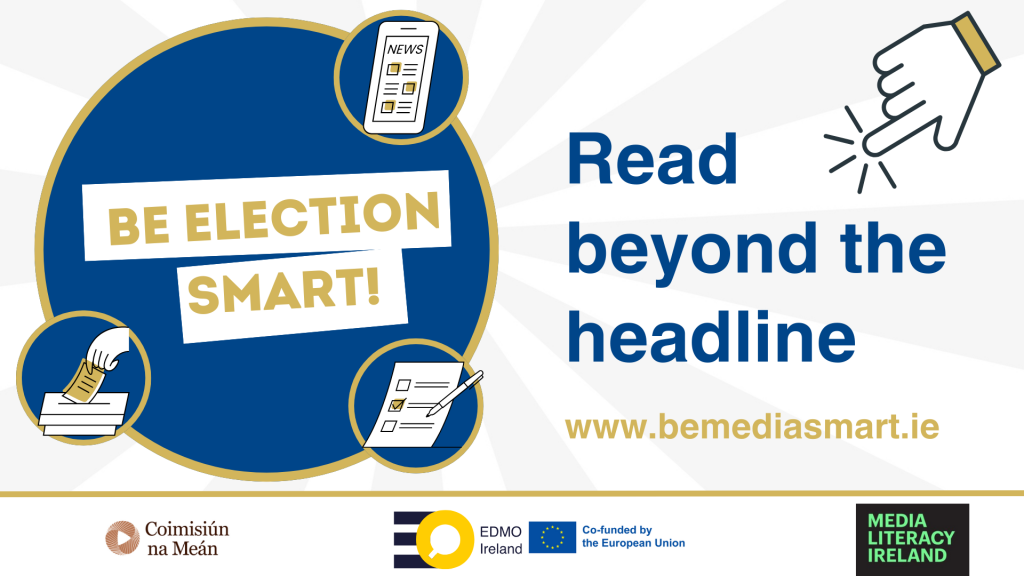
Reading beyond the headline is essential because headlines are designed to capture your attention. That’s why they often oversimplify, distort, or omit crucial details about the story. You need to read the full article to understand the context including potential bias by the author and subtle cues about intent and the reliability of the sources. Read more about misleading headlines here.
Leid #1 Léigh níos mó ná an ceannlíne amháin

Tá sé ríthábhachtach léamh níos mó ná an ceannlíne amháin toisc go scríobhtar ceannlínte go sonrach chun d’aird a tharraingt. Ciallaíonn sé sin go ndéanann siad róshimpliú ar an scéal, go gcuireann siad casadh san fhírinne nó go bhfágann siad sonraí ríthábhachtacha faoin scéal ar lár go minic. Ní mór duit an t-alt iomlán a léamh chun an comhthéacs a thuiscint, lena n-áirítear claontacht fhéideartha ón údar agus leideanna caolchúiseacha maidir le cuspóir agus iontoafacht na bhfoinsí. Léigh tuilleadh faoi cheannlínte míthreoracha anseo.
Tip #2 Look for the whole picture
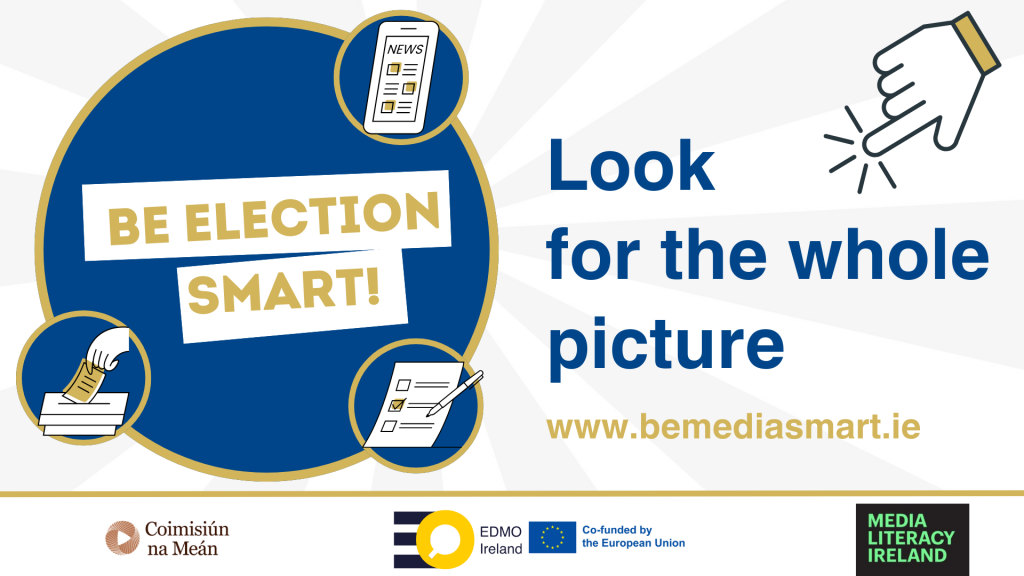
Visual communication is powerful and appealing because our brains are highly adapted to process and interpret visual information quickly and intuitively. But images can be highly deceptive and, in the context of news and election, images can distort our perceptions of people and issues. It only takes a few clicks to change or enhance visual content, but distortion can occur without even doctoring an image. It’s important to remember that visual communication is always the result of choices: choices about what to show and how to crop or frame the image. Read more about misleading visual communication here.
Leid #2 Fiosraigh an scéal iomlán
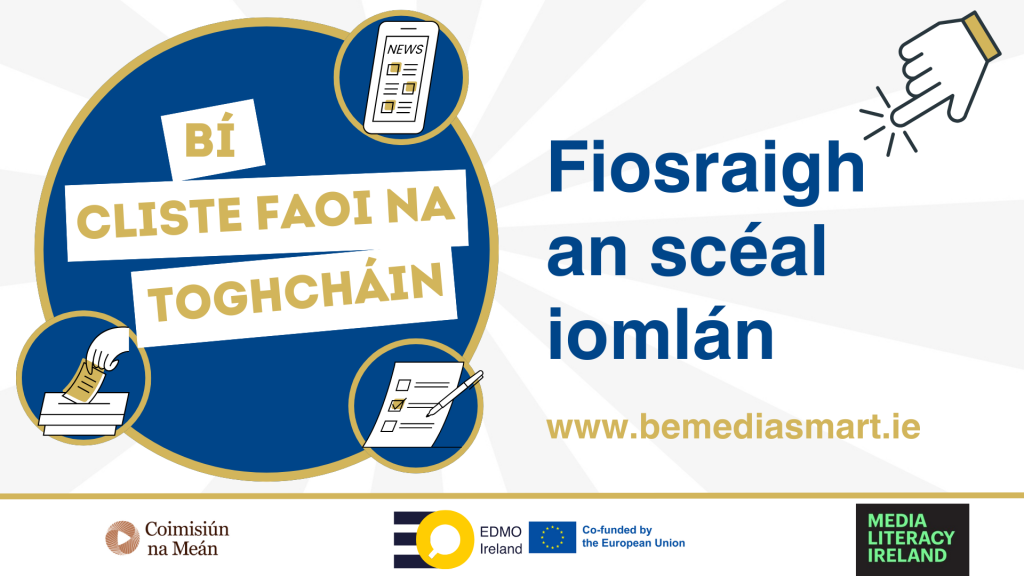
Tá cumarsáid amhairc cumhachtach agus mealltach toisc go bpróiseálann ár n-inchinn faisnéis amhairc go tapa agus gan smaoineamh. Ach is féidir le híomhánna dallamullóg a chur orainn, agus i gcomhthéacs nuachta agus toghcháin, is féidir le híomhánna sinn a chur amú maidir le daoine agus saincheisteanna. Ní thógann sé ach cúpla clic chun ábhar amhairc a threisiú, ach is féidir le híomhánna dallamullóg a chur orainn fiú nuair nach n-athraítear iad. Tá sé tábhachtach a thuiscint go mbaineann cumarsáid amhairc le roghanna i gcónaí – roghanna i dtaobh cad a thaispeántar agus cad a fhágtar ar lár. Léigh tuilleadh faoi chumarsáid mhíthreorach anseo.
Tip #3 Look beyond engagement metrics
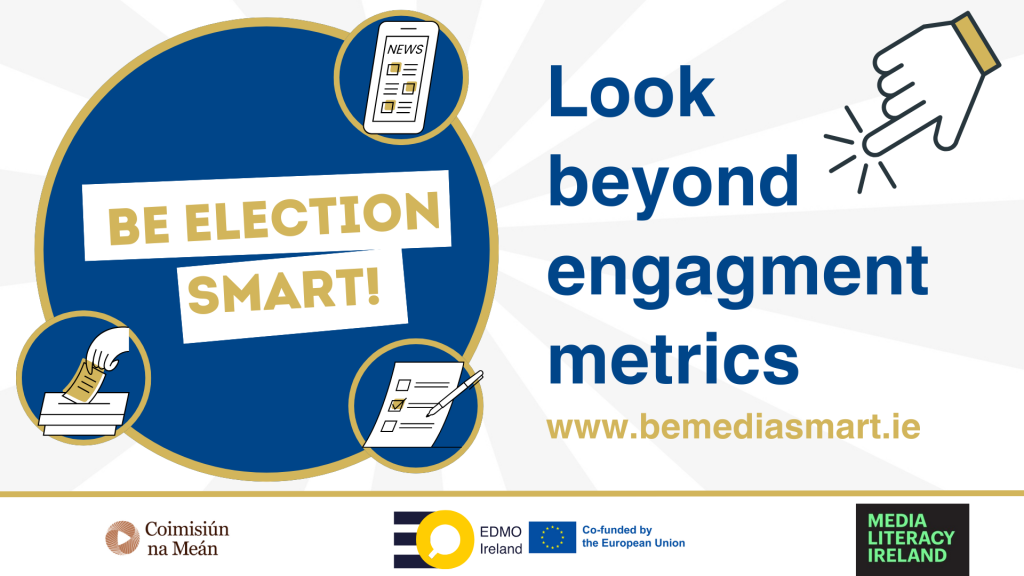
Engagement metrics – such as likes, shares, comments, or views – are not reliable indicators of content quality. Social media and messaging applications make it really easy to share information quickly to large groups of people. In addition, AI-powered technology can also be used to create fake profiles and promote false or inaccurate content, making it go viral with very little authentic sharing. Read more.
Leid #3 Ná féach ar an méadracht rannpháirtíochta amháin
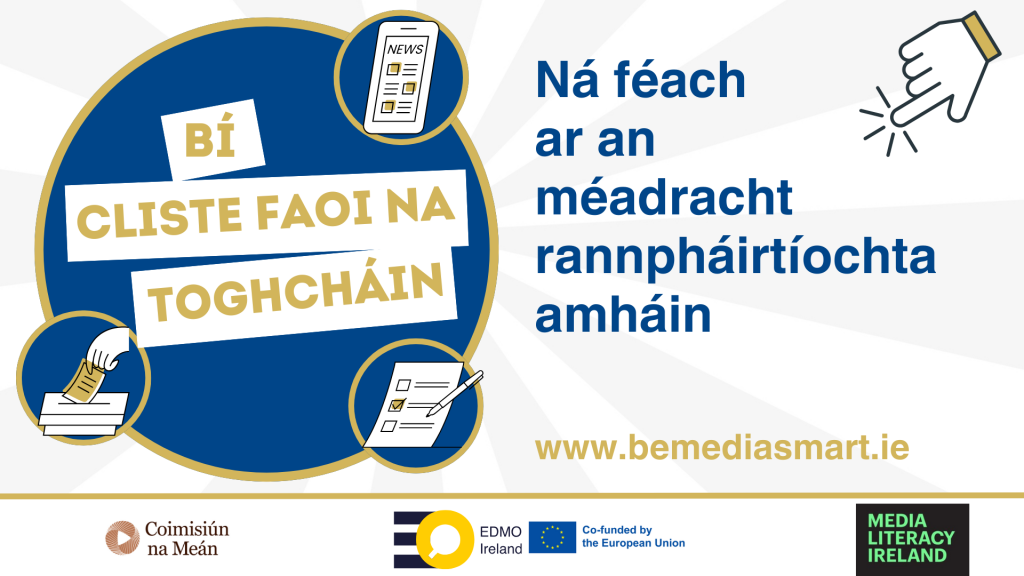
Ní féidir brath ar mhéadracht rannpháirtíochta – amhail líon na ndaoine a d’fhéach, a roinn, a d’fhág nóta tráchta nó a thug ‘is maith liom’ d’ábhar ar líne mar tháscairí ar cháilíocht an ábhair. Tá sé an-éasca eolas a roinnt go tapa le grúpa mór daoine ar na meáin shóisialta agus ar aipeanna teachtaireachtaí. Chomh maith leis sin, le teicneolaíocht atá cumhachtaithe ag AI, is féidir próifílí bréagacha a chruthú a chuireann ábhar bréagach nó míchruinn chun cinn, rud a fhágann go mearscaiptear an t-ábhar sin agus nach roinntear ach fíorbheagán ábhar iontaofa. Léigh tuilleadh.
Tip #4 Compare information sources
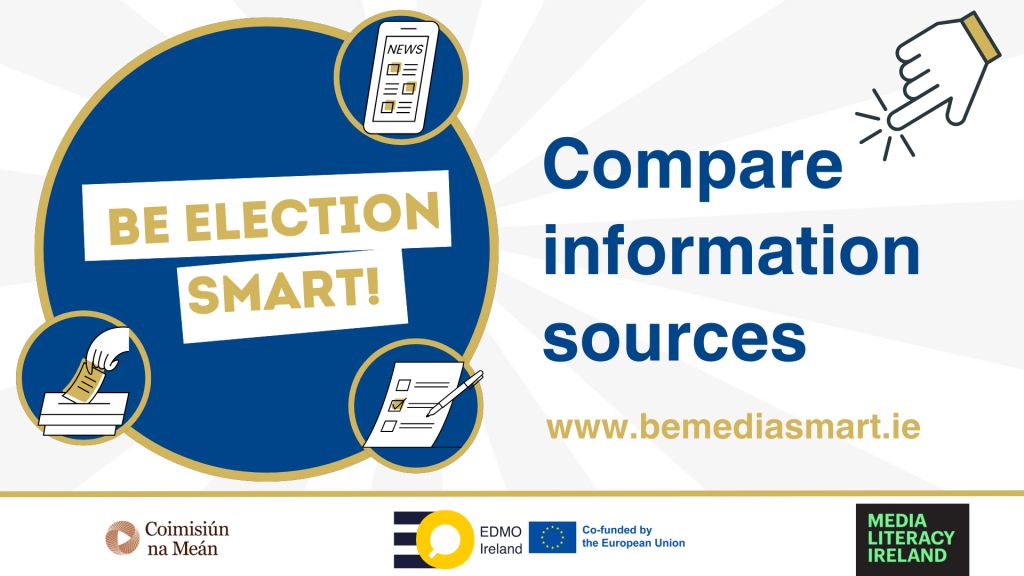
If a piece of information is only being reported from one source or one media type, it might not be the whole story. Ask yourself who produced it, why, and how it has reached you? Comparing sources allows you to see the bigger picture and make more informed decisions. When you read multiple accounts of the same story, you can identify patterns in what is included or omitted. For instance, a political event might be framed positively by one outlet and negatively by another. Comparing these helps you separate opinion from fact. Verifying facts across different sources increases your confidence in their accuracy. If multiple reputable outlets report the same data, it’s more likely to be reliable than information found in only one place. Read more here.
Leid #4 Cuir foinsí faisnéise i gcomparáid le chéile
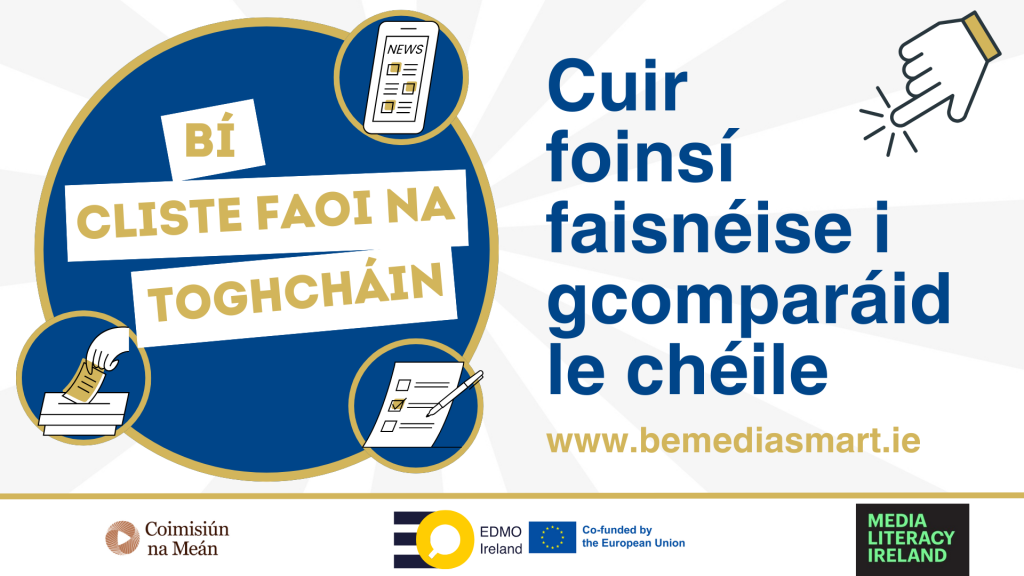
Mura bhfuil píosa faisnéise á thuairisciú ach ag foinse amháin nó ar mheán amháin, b’fhéidir nach an scéal ar fad atá i gceist. Fiafraigh díot féin cé a rinne é, cén fáth agus conas ar tháinig sé chomh fada leat? Trí fhoinsí a chur i gcomparáid le chéile, is féidir leat an scéal iomlán a fháil agus cinntí níos feasaí a dhéanamh. Nuair a léann tú cuntais iomadúla ar an scéal céanna, is féidir leat patrúin a aithint i dtaobh cad a chuirtear san áireamh agus cad a fhágtar ar lár. Mar shampla, d’fhéadfadh cuntas dearfach a bheith ar imeacht polaitiúil i bhfoinse amháin agus cuntas diúltach a bheith i bhfoinse eile. Má chuirtear na foinsí seo i gcomparáid le chéile, is féidir leat teacht ar an bhfírinne seachas tuairimí amháin. Nuair a dheimhnímid na fíricí i bhfoinsí éagsúla, tá a fhios againn gur féidir brath ar a gcruinneas. Má thuairiscítear na sonraí céanna i bhfoinsí iomadúla creidiúnacha, is mó seans go bhfuil an fhaisnéis seo iontaofa murab ionann is an fhaisnéis nach bhfaightear ach i bhfoinse amháin. Léigh tuilleadh anseo.
Tip #5 Don’t share until you verify it is true
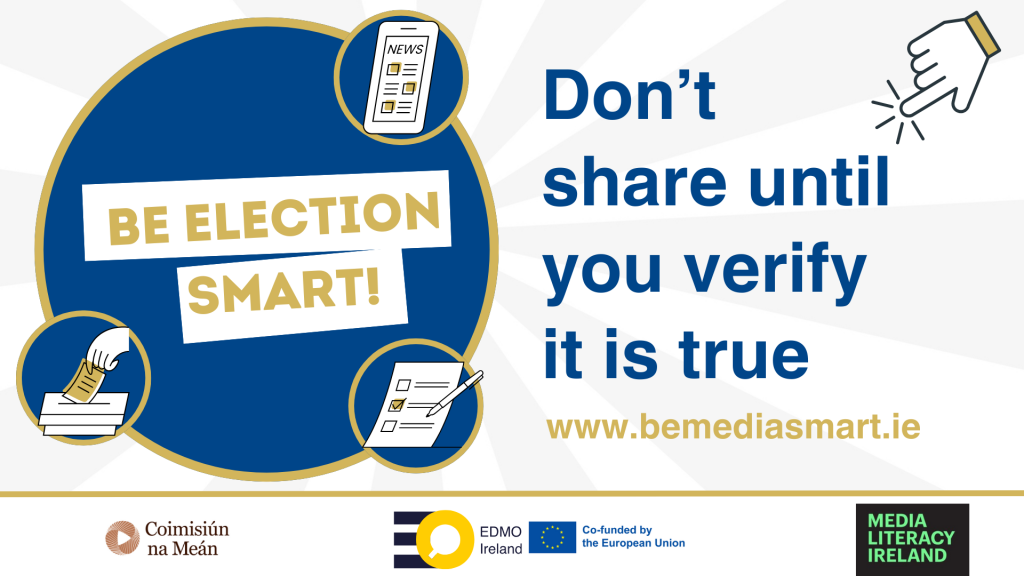
The final days before an election are prime time for dubious information. A last-minute falsehood leaves little time for journalists and fact-checkers to respond. Even if it is debunked quickly, the confusion can shift the narrative around candidates and parties. We all have a critical responsibility to check if information is true before we share it. Read more here.
Leid #5 Deimhnigh go bhfuil an fhaisnéis fíor sula roinneann tú í
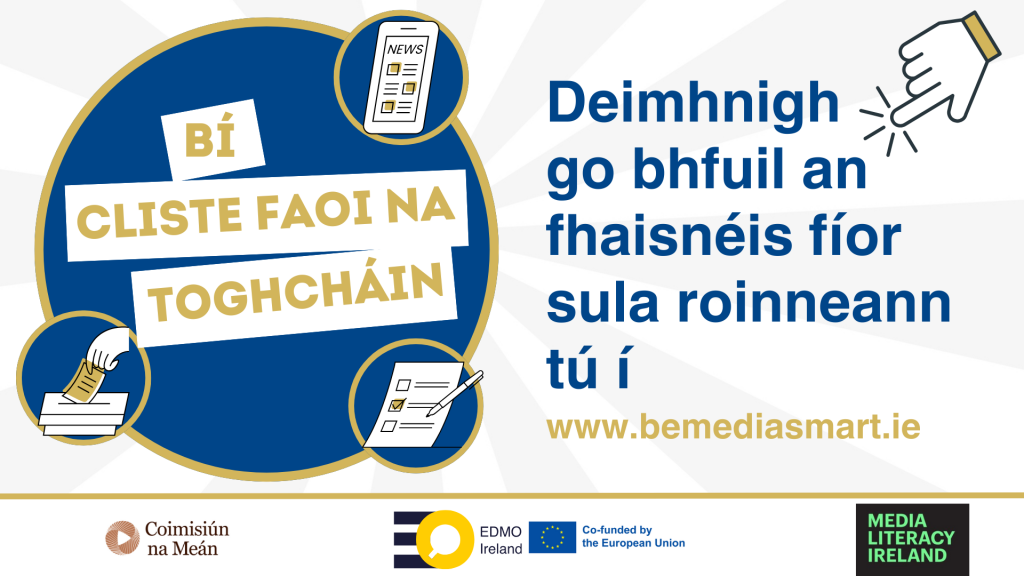
Scaiptear faisnéis amhrasach go forleathan sna laethanta deiridh roimh thoghchán. Nuair a scaiptear bréag ag an nóiméad deireanach, is beag am atá ag iriseoirí agus seiceálaithe fíricí chun freagra a thabhairt. Fiú má nochtar an fhírinne go tapa, d’fhéadfadh an mearbhall a chruthaítear an dearcadh i leith páirtithe agus iarrthóirí a athrú. Tá freagracht ríthábhachtach orainn go léir a chinntiú go bhfuil an fhaisnéis fíor sula roinnimid í. Léigh tuilleadh anseo.
Tip #6 Get voting information from official sources
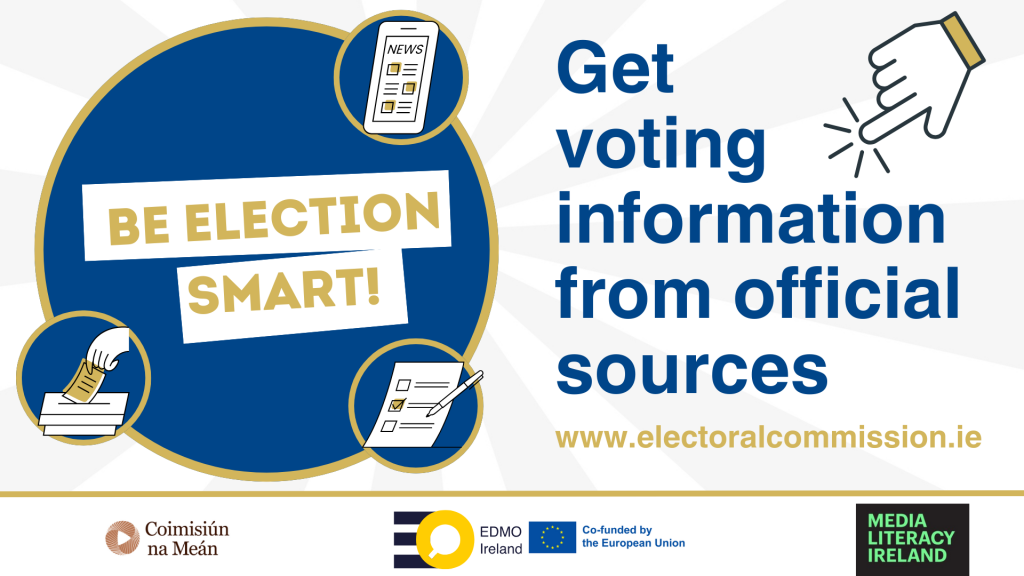
Disinformation around the electoral process often spreads before and after elections, aiming to delegitimise elections through unfounded claims of voter fraud, foreign influences and unfair practices. Seek out reliable information on how, when and where to vote in the elections from official sources. Visit the Electoral Commission website.
Leid #6 Faigh eolas faoi vótáil ó fhoinsí oifigiúla

Is minic a scaiptear bréagáisnéis faoin bpróiseas toghcháin roimh na toghcháin agus ina ndiaidh. An aidhm atá leis seo ná tábhacht agus dlisteanacht na dtoghchán a mhilleadh le ráflaí gan bhunús faoi chalaois toghcháin, tionchair eachtrannacha agus cleachtais mhíchothroma. Faigh eolas iontaofa ó fhoinsí oifigiúla faoi chonas, cathain agus cén áit ar chóir vótail sna toghcháin. Breathanigh ar láithreán gréasáin an An Coimisiún Toghcháin.
